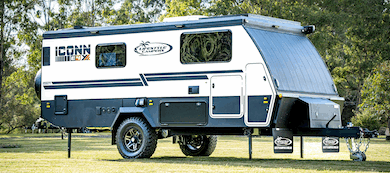7 Insights to Help You Navigate 2024
RV dealer industry statistics show challenges and opportunities for success.

As we head out of the first quarter of the year and into the next one, it’s important to make sure you’re still on course with your goals. Are they aligned with consumer expectations? Are you taking into account trends in automation, analytics and network security in your business operations?
We surveyed our customer database of RV dealers across North America to find out how technology and personalization will fuel dealers’ growth in 2024. Here are the findings.
1. Dealers anticipate rising product prices to be their biggest challenge this year.
2023 proved to be a difficult financial year for the RV industry. The steep hike in interest rates cooled down the market, and many dealers struggled with aging inventory sitting out on their lots. While 2024 is anticipated to be a better financial year, dealers should still brace themselves for a harder sell.
What does this mean for dealers?
Owners can benefit from diversifying revenue sources within their dealerships. There is an opportunity to drive more business to your service department – after all, the surge in RV sales in previous years points to a future demand for repair and maintenance services. Dealers can also differentiate their business by offering mobile service options and post-service benefits.
Let’s also not forget the opportunity to turn accessories into a profit center. Consumers want more customization and enhancements to their units than ever before. Dealers should consider having someone on their team who specializes in accessory sales, and who can provide tailored recommendations.
2. Dealers want to automate their warranty submissions, analytics reporting and status updates.
Hiring and retaining talent was the second biggest challenge dealers surveyed expected to face this year. Many dealerships are operating with lean teams. Luckily, there are plenty of opportunities to automate time-consuming and tedious processes within the dealership. Warranty submissions were the biggest process dealers wanted to automate (57%), followed by analytics reporting (43%) and status updates (43%), then parts ordering (40%).
What does this mean for dealers?
Dealers should work with their dealership management software providers to see what automation functionalities they can leverage to have the biggest impact on their operations. Automating processes like status updates, running reports, scheduling service and parts matching and ordering can all significantly decrease repair event cycle times (RECT).
3. Dealers report that bank financing options are used the most by their customers.
Despite 2023 being a slower financial year overall, our survey reported that most customers who did buy an RV bought new (69%). Even more notably, our market data showed that the finance and insurance (F&I) department’s performance remained at a high in 2023, with F&I contributing 50% of the total gross profit for each RV sale. What’s more, 2023 saw a 62% growth in finance penetration, suggesting that consumers are still willing, or even keen, to finance their RV purchases.
What does this mean for dealers?
This interest in financing presents a clear avenue for the F&I department to increase its profits. With 75% of survey respondents reporting that customers most commonly opt for bank financing, dealers would be wise to look for opportunities to work with lending institutions to design flexible and/or in-house financing options.
4. Families with young children show the most interest in buying RVs.
According to our survey, families are the most common demographic looking to buy an RV, followed by millennials/Gen Z and retirees coming in a close third. This is a trend we have seen on the rise over recent years for a few reasons: the high cost of travel makes campers an attractive vacation option for families, and the high cost of living makes mobile homes an alternative for people looking to enter the housing market.
What does this mean for dealers?
Dealers aren’t just selling RVs – they’re selling the RV lifestyle. They should look for opportunities to sell that lifestyle in marketing campaigns. Now is also the time to invest in a content marketing strategy – these audiences are content fanatics. Dealers can create content that will get them interested in the RV lifestyle and find ways to connect their brand with that lifestyle.
5. Dealers are concerned about cybersecurity threats against their digital infrastructure.
Over the past few years, there have been numerous reports of dealerships facing data breaches. In 2021, Black Kite published a report titled “Ransomware Risk: Automotive Manufacturing in 2021” that cited a whopping 17% of automotive suppliers surveyed were at a high risk of ransomware attacks.
Consumers are also fearful of the threat posed to their data once it’s handed over to a business. That’s why cybersecurity isn’t just important for network stability, but also for building customer trust.
What does this mean for dealers?
Many RV dealerships are moving to cloud security in their bid to bolster cybersecurity. By keeping data in a remote, highly secure facility, dealers can access their data at any time while also shielding it from cyber – and environmental – threats.
6. The demand for eco-friendly RVs and add-ons is here to stay.
In our 2023 survey, we asked dealers if they were supplying eco-friendly add-ons and 90% said yes. In this year’s survey, 53% of dealers said they hadn’t noticed an increased demand for eco-friendly RVs and features, but a not insignificant 34% said they had seen a slight increase.
Several major manufacturers have announced their electric camper vans, like the Winnebago eRV2 and the Thor Vision Vehicle. Dealers can expect to see more electric options entering the market in the coming years.
What does this mean for dealers?
Consumers are more conscious than ever of the impact of their purchasing habits on the environment. Dealers have an opportunity to market a lower-footprint lifestyle with sustainable and off-grid vehicles and add-ons.
7. Customers expect faster service and more mobile service options.
According to our survey, 53% of respondents said they have noticed customers expecting faster service turnaround times. What’s more, 34% of respondents have seen an increased demand for mobile service. We are seeing more and more dealers offering mobile services where technicians visit the customer’s location for minor repairs and maintenance. This can alleviate some pressure from the service bays and offer a convenient solution for customers.
What does this mean for dealers?
Every dealership should be measuring its RECT. After all, if you don’t measure it, you can’t manage it. Breaking down each part of the work order allows dealerships to pinpoint areas of improvement. Then, teams can employ techniques like setting up triage teams to expedite work orders, ensuring units are serviced promptly.



